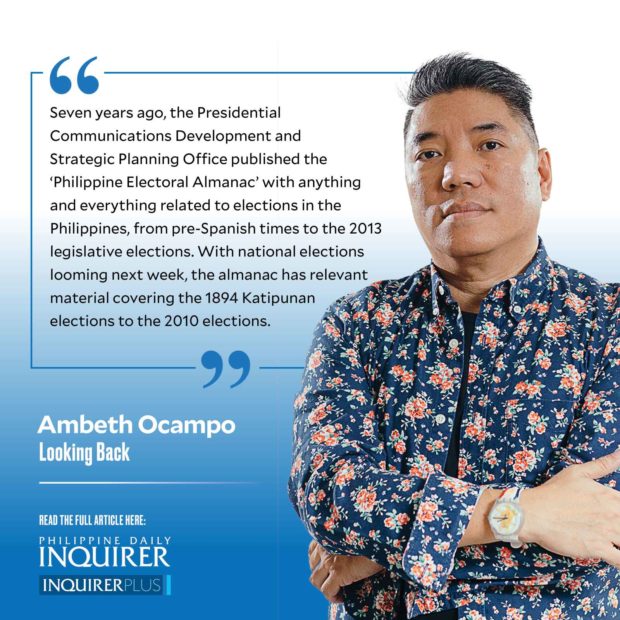Electoral almanac
 Almanacs are an annual compilation of astronomical and meteorological information useful for farmers and fishermen. In the days before Google, Filipinos had recourse to Honorio Lopez’s “Dimasalang Kalendariong Tagalog” that first came out in 1898 under the original title “La Sonrisa” (The Smile). I bought my copy, in the 1980s, from a stall outside Quiapo church, where it was peddled alongside an assortment of anting-anting, herbs, and oils. I was originally looking for a deck of Spanish playing cards for “panguingue” called “sotang bastos” when the almanac caught my eye. “Dimasalang” is one of Rizal’s pseudonyms, translated from the original Tagalog “hindi masalang,” to English it is “Can’t be touched,” or in Latin “Noli me tangere.”
Almanacs are an annual compilation of astronomical and meteorological information useful for farmers and fishermen. In the days before Google, Filipinos had recourse to Honorio Lopez’s “Dimasalang Kalendariong Tagalog” that first came out in 1898 under the original title “La Sonrisa” (The Smile). I bought my copy, in the 1980s, from a stall outside Quiapo church, where it was peddled alongside an assortment of anting-anting, herbs, and oils. I was originally looking for a deck of Spanish playing cards for “panguingue” called “sotang bastos” when the almanac caught my eye. “Dimasalang” is one of Rizal’s pseudonyms, translated from the original Tagalog “hindi masalang,” to English it is “Can’t be touched,” or in Latin “Noli me tangere.”
A small, white, crudely printed pamphlet, it stood out among the novenas with Rizal’s face on the cover together with: José Burgos, Graciano López Jaena, Marcelo H. del Pilar, Apolinario Mabini, and Andres Bonifacio. A Tagalog calendar was supplemented with: phases of the moon, astrological signs, a weather forecast for the month, and two names of the saints for each day, useful for newborn babies in need of baptismal names.
“Kalendariong Tagalog 1922” is available online from Project Gutenberg. Its weather forecast for January 1922 being “variable with strong wind or rain from the East.” Jan. 1, a Sunday, commemorated “Ang unang pagtuló ng dugô ng ating mahal na Mananakop” (First shedding of blood of our beloved Redeemer). In the present church calendar, Jan. 1 is the Solemnity of Mary Mother of God, revised from the traditional Feast of Our Lord’s Circumcision. This explains why some unfortunate children, born on the first of January, were christened Circuncision or Circumcision, instead of the saints of the day, Eufrosina/Eufrosino or Magno/Magna. Adding Pinoy humor to injury, Circuncisions were given the palayaw or pet name “Tuli.” Google images show a 2014 edition of the “Kalendariong Tagalog” so I guess the descendants of Honorio Lopez (1875-1958) continue to print it to this day.
Seven years ago, the Presidential Communications Development and Strategic Planning Office published the “Philippine Electoral Almanac” with anything and everything related to elections in the Philippines, from pre-Spanish times to the 2013 legislative elections. Those who have no recourse to the handsome hardcover edition can download a digital copy from archive.org. With national elections looming next week, the almanac has relevant material covering the 1894 Katipunan elections to the 2010 elections. When updated with the results of the 2016 and 2022 elections, two names will be added to the roster of presidents. Seventeen elected presidents counting from 1935.
An interesting feature of the almanac are the infographics. For example, one can trace the evolution of the Great Seal of the Republic all the way down to Spanish times. Election data is presented not as boring tables with names, numbers, and place names but in pie charts and maps of the Philippines that clearly show in images how an election was won or lost by candidates or political parties. In a section on Philippine Elections by the Numbers, for example, it states that from 1986-2010 all presidents hailed from Luzon: Cory Aquino (Tarlac), Fidel Ramos (Pangasinan), Joseph Estrada (San Juan), Gloria Macapagal Arroyo (Pampanga), and Benigno Aquino III (Tarlac). In 2016, Rodrigo Duterte (Davao) finally added someone from Mindanao to the list. Before President Duterte, all the non-Luzon presidents were from the Visayas: Sergio Osmeña (Cebu), Manuel Roxas (Capiz), and Carlos Garcia (Bohol). Three presidents were Ilocanos: Quirino, Magsaysay, and Marcos. Only two women have served as president: Aquino and Arroyo, both of them swept into office by people power.
Do not mistake the data for trivia, because history is not always about data but the connections between facts. How one arranges data to find a pattern, to connect the dots, or form a picture when grappling with a jigsaw puzzle, is what makes history come alive. With the base material already compiled, one hopes that Manolo Quezon, editor in chief of the early editions, will continue to update the electoral almanac for the reference and enjoyment of the public.
—————-
Comments are welcome at aocampo@ateneo.edu




















